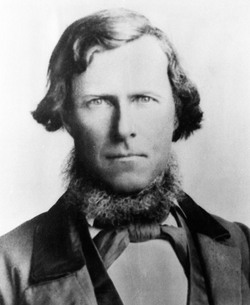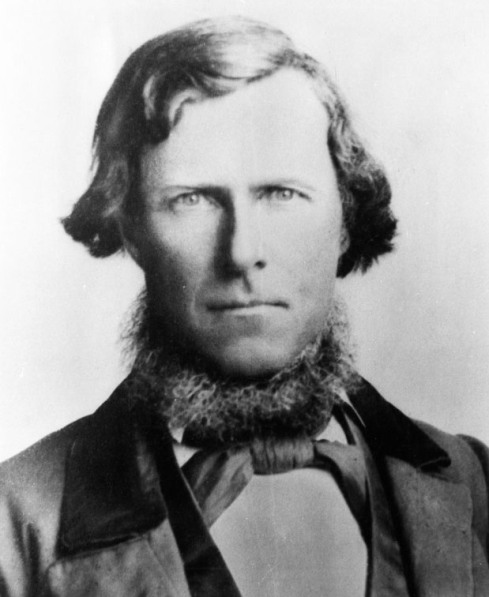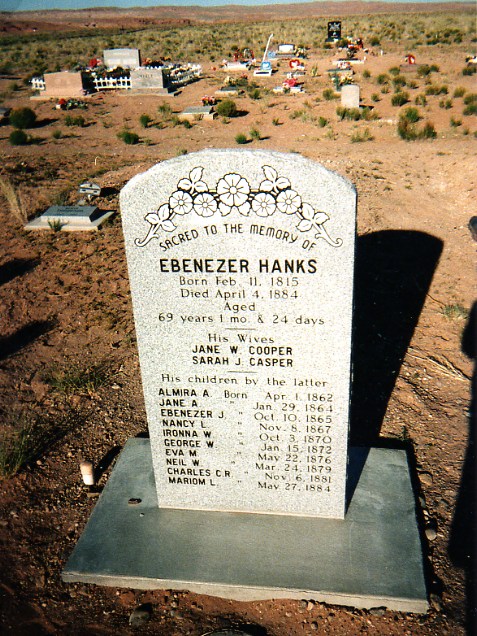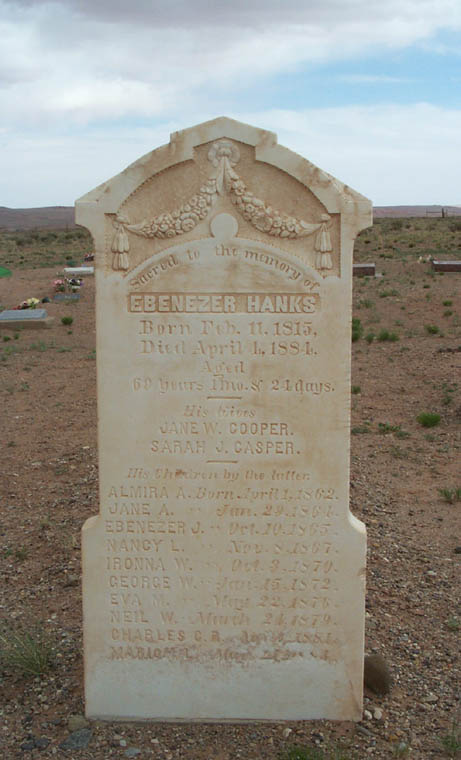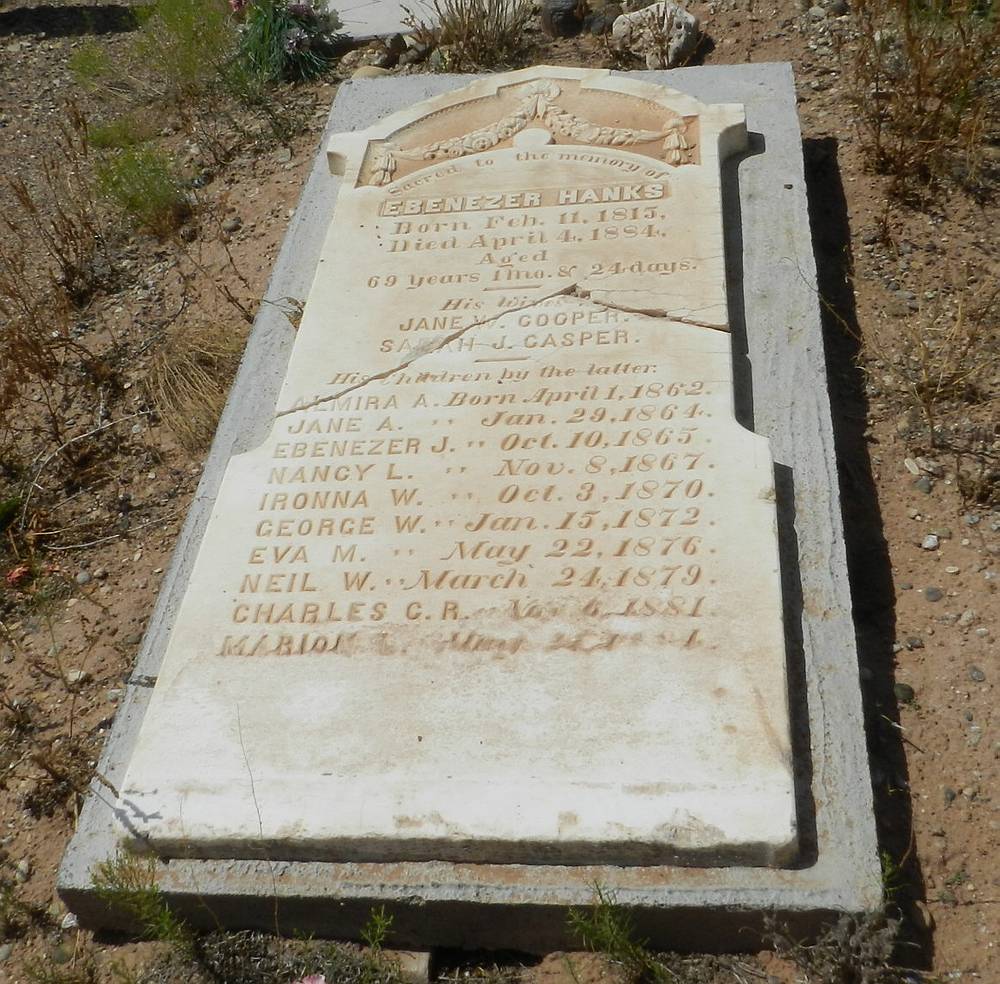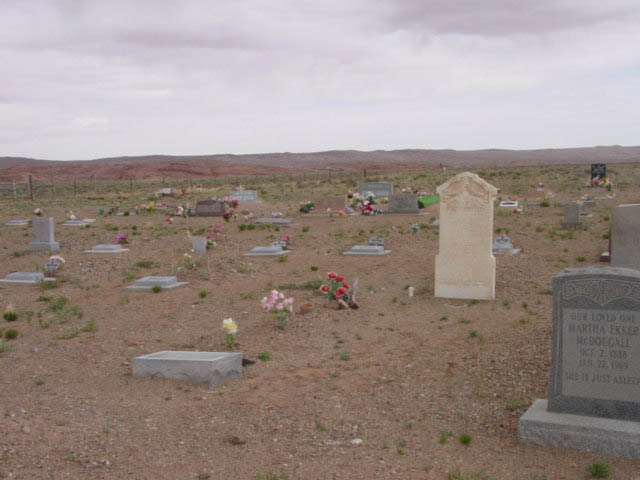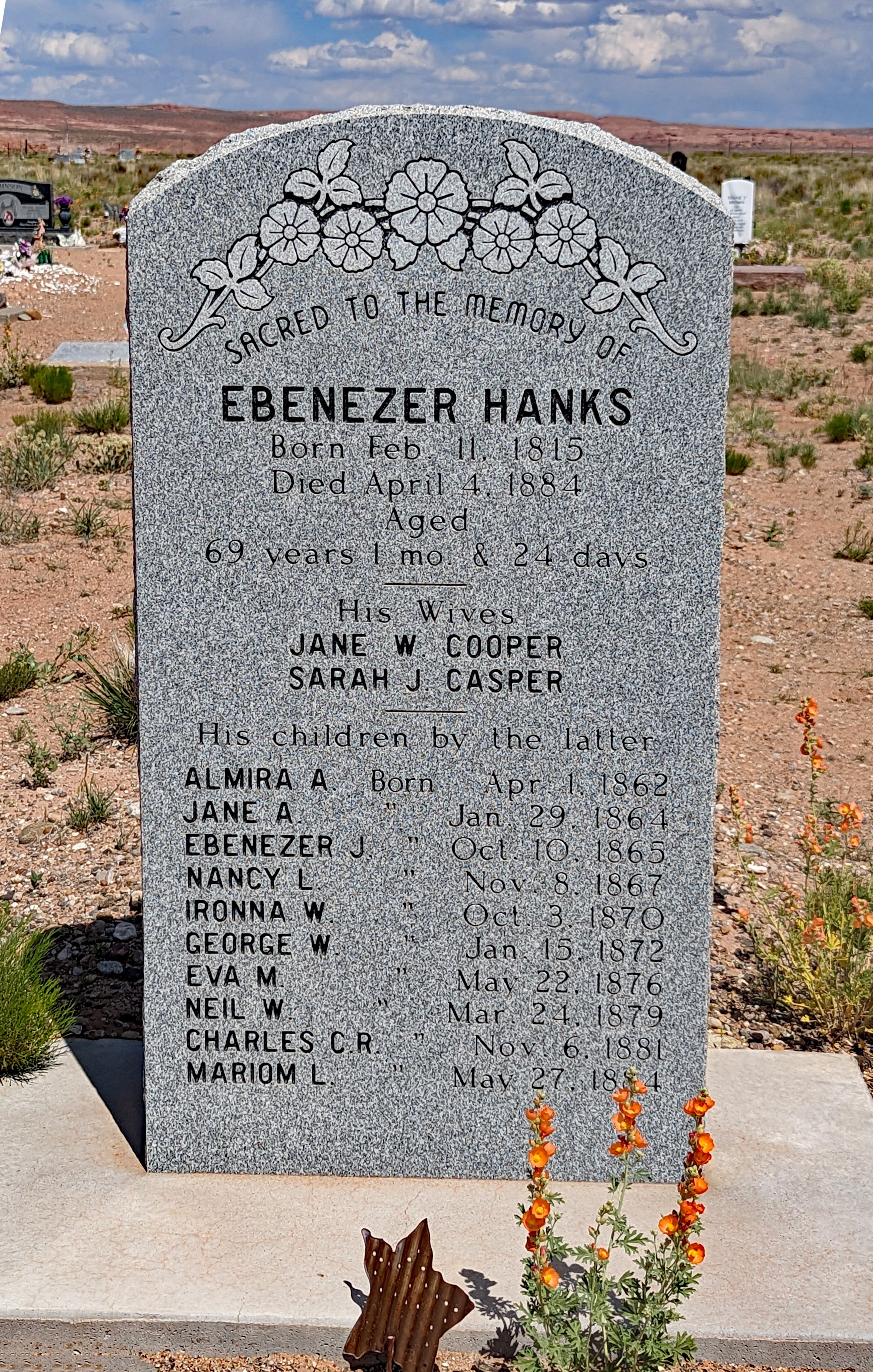Married Jane Wells Cooper, 28 Oct 1839, Adams, Illinois.
Children: Martha Catherine Hanks, Jane Wells Hanks.
Married Sarah Jane Casper, 22 Jan 1861, Salt Lake City, Salt Lake, Utah.
Children: George W. Hanks, Jane Allie Hanks, Ebenezer Joseph Hanks, Irona Wealthy Hanks, Neal Wendell Hanks, Almira Ann Hanks, Eva May Hanks, Marion Lyman Hanks, Charles Rich Hanks, Nancy Luella Hanks.
Parentage of Ebenezer Joseph Hanks - About 1814 Almira Kennedy, a "highland Scotch lassie, an ardent covenanting Presbyterian had Christian," fell in love with and married Joseph Hanks. Almira's father, Neal Kennedy, had migrated to the Scotch settlements of Argyle, Washington County, New York, prior to 1790. Family tradition insists that Neal came to New York as a young man, had excellent penmanship, and served as an orderly sergeant under Washington during the American Revolution. Setting a bear trap, Neal Kennedy accidentally tripped it and was killed. However, he had brought up his daughter to be "refined, for the times, educated, talented, gentle and true."
"The exact opposite," is how her new husband, Joseph Hanks, was described. He was a "rough, profane man," and was not religious. His grandfather, John Hanks, had been an early settler in western New York, and Joseph was descended from some of the oldest English families in America, including Richard Warren, a passenger on the Mayflower. Perhaps his heritage of religious intensity had soured him on religion. In any case, the Hanks' had enjoyed a station in life a cut above the average.
Joseph Hanks, a veteran of the War of 1812 (he had fought in it only toward the end), was a highly skilled blacksmith, took pride in his work, and insisted on excellence. His skills as a smith, and with all kinds of farm tools, was passed on to his children.
Birth - The first child born to this couple was on a cold, wintery February day in 1815 and was named Ebenezer after Joseph Hanks' brother-in-law, Ebenezer Rogers. Symbolic of the transitory nature of life, as Almira was giving birth to the next generation of Hanks' in America, old John Hanks, patriarch of the clan who had left secure Connecticut to settle in New York, was living on his farm at the ripe old age of eighty-five. Twelve days after Ebenezer's birth, John Hanks expired and was buried in the family plot on his farm.
"Ebenezer" was the name much too long to be used every day, and so the boy was soon called "Eb," a nickname that stuck to him for the rest of his life. Conversion
1839-1840 the Mormons were fleeing from Missouri persecutions to settle temporarily in Adams County. Hundred of destitute and desperate believers were driven out of Missouri in the winter of 1839 and the people of Adams County were so touched by their plight that they took up subscriptions to assist them. In later years George Washington Bean recalled how his father, also an early day resident of Adams County, had put up many of the refugees, offering them the use of his buildings and assisting them in any way he could. It is likely that Eb and Jane contributed to that cause. With a number of Adams County settlers, the contacts led to questions about religion which resulted in baptisms. By 1841 Jane was a member of the "Mormon" Church, and it is probable that Eb was baptized about the same time.
And after their baptism, they did not join the "Gathering" to the new Mormon settling place, Nauvoo in Hancock County, but stayed instead in Adams County. They were therefore removed from some of the continuing Mormon controversies.
In June, 1843, the Prophet was arrested for alleged complicity in the attempted assassination of Lilburn W. Boggs, former governor of Missouri. Family tradition says that Eb was called out as part of the Mormon "army" that rode into northern Illinois to join Smith as an "escort," and get him back safely to Nauvoo. Soon Eb and the others in the "escort" greatly outnumbered the Missouri sheriff and his posse, and on June 30th the escort service was completed. That afternoon several thousand people assembled to hear Joseph Smith preach in a nearby grove. He was soon after released by a sympathetic Nauvoo court.
While Eb was gone to guard Joseph Smith, it is said that three Mormons rode up to the Hanks homestead and found that ten acres of timber had been cleared and fenced. Knowing that Jane was a Mormon, they asked if they could put some cattle into the field that night.
"Why not take them in now?" questioned Jane.
"They are some we have lifted," responded one of the men, "and we can't take them in before dark."
By February 1846, the Saints were streaming out of the city. Little is recorded of Eb and Jane's last days there, or the trip to temporary Mormon headquarters in Council Bluffs, Iowa. But Eb did tell his son years later that he had a good team when he started, and recalled how he shot turkeys at moonlight for food. With many of the Saints already starving, this was a valuable godsend. As many as six hundred Mormons starved and froze to death that dismal winter and spring.
Mormon Battalion - Salvation came in a strange way for Eb and Jane. A war with Mexico had recently been declared, and as a goodwill gesture to the Mormons, President Polk authorized the raising of a "Mormon Battalion" for service in that war with the hope in mind that the tree transportation to California would be beneficial to the Mormons and keep them loyal to the United States.
Because they had no children, it was decided that both Eb and Jane would go, with Jane working as a cook and washerwoman to supplement Eb's $13 a month income. Perhaps another inducement to join was the knowledge that Jane's younger brother, Wendell, had recently enlisted in a "Gentile" company.
Life in Utah - Ebenezer ran a freighting business between Los Angeles and Salt Lake City. In 1860 he came to Salt Lake Valley and met with President Young who persuaded him to go to Iron County and build a cotton factory at Parowan. According to the record, President Young was co-partner with Mr. Hanks in this venture. The President knew that Wm. Marsden, an expert machinist was living in Provo, and asked Hanks to confer with him, as he had worked in the cotton business in England.
After the settlement of Dixie, President Young could see the necessity of a cotton factory closer to the cotton fields. He sold his interest in the Cotton Factory to Ebenezer Hanks. Due to the scarcity of cotton, in 1866 it ceased operating as a cotton factory and was turned into a wool scouring and carding plant. Wool was washed and dried then carded into rolls about twelve to sixteen inches long and from one to two inches thick. This was a great help to the women. It could soon be spun into yarn and ready for the hand loom or used as it was for the inside of quilts. The pioneer children were kept busy carrying big baskets of rolls to their mothers.
Parowan Stake House is one of the old-time structures erected less than fifteen years after the arrival of the first pioneers. Ebenezer was one of the architects. Ebenezer was also to take charge of the iron foundry. He started a freighting business that made him rich.
In 1882 he moved to Wayne county where, with Samuel and Charles Gold, Joseph Sylvester and E. H McDougall, he was instrumental in building the little community later named Hanksville in his honor. Ebenezer Hanks died in April 1884, from the fall off a roof, his death being the first in the settlement. An imposing tombstone, purchased by Apostle Francis M. Lyman, marks his grave.
"Ebenezer Hanks Story" by Kerry William Bate available on microfilm #1033891, item #3, Family History Library
Mormon Battalion, Company E
Married Jane Wells Cooper, 28 Oct 1839, Adams, Illinois.
Children: Martha Catherine Hanks, Jane Wells Hanks.
Married Sarah Jane Casper, 22 Jan 1861, Salt Lake City, Salt Lake, Utah.
Children: George W. Hanks, Jane Allie Hanks, Ebenezer Joseph Hanks, Irona Wealthy Hanks, Neal Wendell Hanks, Almira Ann Hanks, Eva May Hanks, Marion Lyman Hanks, Charles Rich Hanks, Nancy Luella Hanks.
Parentage of Ebenezer Joseph Hanks - About 1814 Almira Kennedy, a "highland Scotch lassie, an ardent covenanting Presbyterian had Christian," fell in love with and married Joseph Hanks. Almira's father, Neal Kennedy, had migrated to the Scotch settlements of Argyle, Washington County, New York, prior to 1790. Family tradition insists that Neal came to New York as a young man, had excellent penmanship, and served as an orderly sergeant under Washington during the American Revolution. Setting a bear trap, Neal Kennedy accidentally tripped it and was killed. However, he had brought up his daughter to be "refined, for the times, educated, talented, gentle and true."
"The exact opposite," is how her new husband, Joseph Hanks, was described. He was a "rough, profane man," and was not religious. His grandfather, John Hanks, had been an early settler in western New York, and Joseph was descended from some of the oldest English families in America, including Richard Warren, a passenger on the Mayflower. Perhaps his heritage of religious intensity had soured him on religion. In any case, the Hanks' had enjoyed a station in life a cut above the average.
Joseph Hanks, a veteran of the War of 1812 (he had fought in it only toward the end), was a highly skilled blacksmith, took pride in his work, and insisted on excellence. His skills as a smith, and with all kinds of farm tools, was passed on to his children.
Birth - The first child born to this couple was on a cold, wintery February day in 1815 and was named Ebenezer after Joseph Hanks' brother-in-law, Ebenezer Rogers. Symbolic of the transitory nature of life, as Almira was giving birth to the next generation of Hanks' in America, old John Hanks, patriarch of the clan who had left secure Connecticut to settle in New York, was living on his farm at the ripe old age of eighty-five. Twelve days after Ebenezer's birth, John Hanks expired and was buried in the family plot on his farm.
"Ebenezer" was the name much too long to be used every day, and so the boy was soon called "Eb," a nickname that stuck to him for the rest of his life. Conversion
1839-1840 the Mormons were fleeing from Missouri persecutions to settle temporarily in Adams County. Hundred of destitute and desperate believers were driven out of Missouri in the winter of 1839 and the people of Adams County were so touched by their plight that they took up subscriptions to assist them. In later years George Washington Bean recalled how his father, also an early day resident of Adams County, had put up many of the refugees, offering them the use of his buildings and assisting them in any way he could. It is likely that Eb and Jane contributed to that cause. With a number of Adams County settlers, the contacts led to questions about religion which resulted in baptisms. By 1841 Jane was a member of the "Mormon" Church, and it is probable that Eb was baptized about the same time.
And after their baptism, they did not join the "Gathering" to the new Mormon settling place, Nauvoo in Hancock County, but stayed instead in Adams County. They were therefore removed from some of the continuing Mormon controversies.
In June, 1843, the Prophet was arrested for alleged complicity in the attempted assassination of Lilburn W. Boggs, former governor of Missouri. Family tradition says that Eb was called out as part of the Mormon "army" that rode into northern Illinois to join Smith as an "escort," and get him back safely to Nauvoo. Soon Eb and the others in the "escort" greatly outnumbered the Missouri sheriff and his posse, and on June 30th the escort service was completed. That afternoon several thousand people assembled to hear Joseph Smith preach in a nearby grove. He was soon after released by a sympathetic Nauvoo court.
While Eb was gone to guard Joseph Smith, it is said that three Mormons rode up to the Hanks homestead and found that ten acres of timber had been cleared and fenced. Knowing that Jane was a Mormon, they asked if they could put some cattle into the field that night.
"Why not take them in now?" questioned Jane.
"They are some we have lifted," responded one of the men, "and we can't take them in before dark."
By February 1846, the Saints were streaming out of the city. Little is recorded of Eb and Jane's last days there, or the trip to temporary Mormon headquarters in Council Bluffs, Iowa. But Eb did tell his son years later that he had a good team when he started, and recalled how he shot turkeys at moonlight for food. With many of the Saints already starving, this was a valuable godsend. As many as six hundred Mormons starved and froze to death that dismal winter and spring.
Mormon Battalion - Salvation came in a strange way for Eb and Jane. A war with Mexico had recently been declared, and as a goodwill gesture to the Mormons, President Polk authorized the raising of a "Mormon Battalion" for service in that war with the hope in mind that the tree transportation to California would be beneficial to the Mormons and keep them loyal to the United States.
Because they had no children, it was decided that both Eb and Jane would go, with Jane working as a cook and washerwoman to supplement Eb's $13 a month income. Perhaps another inducement to join was the knowledge that Jane's younger brother, Wendell, had recently enlisted in a "Gentile" company.
Life in Utah - Ebenezer ran a freighting business between Los Angeles and Salt Lake City. In 1860 he came to Salt Lake Valley and met with President Young who persuaded him to go to Iron County and build a cotton factory at Parowan. According to the record, President Young was co-partner with Mr. Hanks in this venture. The President knew that Wm. Marsden, an expert machinist was living in Provo, and asked Hanks to confer with him, as he had worked in the cotton business in England.
After the settlement of Dixie, President Young could see the necessity of a cotton factory closer to the cotton fields. He sold his interest in the Cotton Factory to Ebenezer Hanks. Due to the scarcity of cotton, in 1866 it ceased operating as a cotton factory and was turned into a wool scouring and carding plant. Wool was washed and dried then carded into rolls about twelve to sixteen inches long and from one to two inches thick. This was a great help to the women. It could soon be spun into yarn and ready for the hand loom or used as it was for the inside of quilts. The pioneer children were kept busy carrying big baskets of rolls to their mothers.
Parowan Stake House is one of the old-time structures erected less than fifteen years after the arrival of the first pioneers. Ebenezer was one of the architects. Ebenezer was also to take charge of the iron foundry. He started a freighting business that made him rich.
In 1882 he moved to Wayne county where, with Samuel and Charles Gold, Joseph Sylvester and E. H McDougall, he was instrumental in building the little community later named Hanksville in his honor. Ebenezer Hanks died in April 1884, from the fall off a roof, his death being the first in the settlement. An imposing tombstone, purchased by Apostle Francis M. Lyman, marks his grave.
"Ebenezer Hanks Story" by Kerry William Bate available on microfilm #1033891, item #3, Family History Library
Mormon Battalion, Company E
Family Members
-
![]()
Almira Ann Hanks McDougall
1862–1925
-
![]()
Jane Allie Hanks Sylvester
1864–1904
-
![]()
Rev Ebenezer Joseph "Eben" Hanks
1865–1956
-
![]()
Luella Nancy Hanks Goold
1867–1944
-
![]()
Irona Wealthy Hanks Davis
1868–1935
-
![]()
Eva May Hanks Thompson
1876–1925
-
![]()
Neal Wendell Hanks
1879–1946
-
![]()
Charles Rich Hanks
1881–1970
-
![]()
Marion Lyman Hanks
1884–1891
Advertisement
Records on Ancestry
Advertisement
